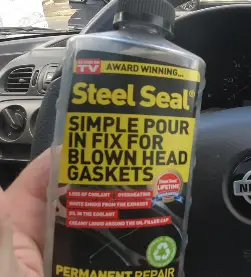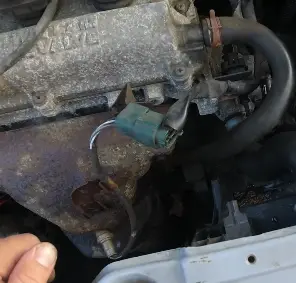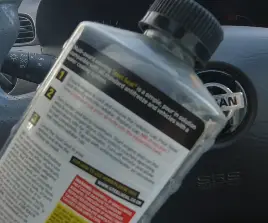Hey there, car enthusiasts and DIY mechanics! If you’re staring down the barrel of a blown head gasket and dreading the thousands it’ll cost to fix, I’ve got something you need to hear about: Steel Seal Head Gasket Sealer. I’ve been through the wringer with my old Subaru, and this product saved me from a wallet-crushing repair bill. In this article, I’m sharing my firsthand experience, diving into the pros and cons, comparing Steel Seal to other brands, and giving you maintenance tips to get the most out of it. Trust me, this stuff is worth a shot!
My Journey With Steel Seal: A Real User’s Tale

Picture this: my 2007 Subaru Forester started billowing white smoke from the exhaust, guzzling coolant like it was going out of style, and running hotter than a summer day in Death Valley. A mechanic confirmed my worst fear—a blown head gasket. The repair quote? A jaw-dropping $2,800. As a guy who loves his car but isn’t made of money, I started hunting for alternatives. That’s when I stumbled across Steel Seal, a pour-in head gasket sealer that promised a DIY fix. Skeptical but desperate, I gave it a try, and boy, do I have a story to tell.
I ordered two bottles for my 2.5-liter engine, followed the instructions to the letter, and drove my car for about 15 miles after pouring it in. At first, I thought it was a bust—coolant was still disappearing. But after a few days of driving, the white smoke vanished, the temperature gauge settled down, and my coolant levels stabilized. It’s been six months, and my Subie’s still running like a champ. That said, it wasn’t all smooth sailing, and I’ll break down the good, the bad, and the ugly for you.
Pros Of Steel Seal Head Gasket Sealer
Read More: My Thought on Zerex G40 vs. G12 Coolant
Steel Seal has a lot going for it, and I’m not just saying that because it worked for me. Here’s why I think it’s a game-changer:
- Easy to use: The instructions are straightforward—pour it into the radiator, run the engine, and drive. Even if you’re not a car guy, you can handle it in under an hour.
- Cost-effective: At about $60-$120 depending on engine size, it’s a fraction of the $2,000+ you’d pay for a professional head gasket replacement.
- Permanent fix for minor leaks: For small cracks or leaks, Steel Seal forms a hardened seal that can last years, as it did for my Forester.
- Money-back guarantee: Steel Seal offers a 30-day refund policy, which gave me peace of mind when I was skeptical about “miracle” products.
- Versatile application: It works on cars, trucks, SUVs, and even motorcycles, regardless of whether they’re gas or diesel engines.
- No clogging: Unlike some sealers that use fibrous materials, Steel Seal’s thermochemical formula won’t gunk up your cooling system.
- Lifetime warranty: If the seal fails during your ownership, they’ll send you a free replacement bottle—no hassle.
- Wide compatibility: It’s safe for most engines, from 4-cylinder compacts to beefy 8-cylinder trucks, as long as they’re water-cooled.
- Saves time: You’re back on the road in a day, compared to a week or more for a mechanical repair.
- Proven track record: Thousands of users, including repair shops, swear by it, and it’s won awards for its effectiveness.
I was blown away by how simple the process was. I didn’t need to disassemble anything or spend hours under the hood. The money-back guarantee was a big plus—I figured I had nothing to lose but a few bucks if it didn’t work. And knowing it wouldn’t clog my radiator gave me confidence to try it on my older car.
Cons Of Steel Seal Head Gasket Sealer
Let’s keep it real—Steel Seal isn’t perfect. Here are the downsides I encountered or learned about:

- Not a guaranteed fix: If your head gasket is severely damaged, Steel Seal might only buy you time, not solve the problem permanently.
- Pricey compared to competitors: At $60-$120, it’s pricier than brands like K-Seal or BlueDevil, which can cost as little as $20.
- Requires flushing: You need to flush your cooling system before use, which adds time and effort, especially if you’re not handy.
- Mixed reviews: Some users on forums like Reddit report it worsening their issues, though I suspect improper application played a role.
- Tricky refund process: The money-back guarantee requires verification by a VAT-registered garage, which can be a hassle for DIYers.
- Multiple bottles for big engines: Larger engines (over 4 liters) need two or three bottles, jacking up the cost.
- Takes time to work: It took three days of driving for me to see results, which can feel like an eternity when your car’s on the fritz.
- Limited for certain leaks: It’s less effective for combustion-to-combustion or combustion-to-oil leaks, as it needs coolant access to work.
- Skepticism from mechanics: Many pros dismiss sealers as “band-aid” fixes, which can make you second-guess using it.
- Temporary for severe damage: For major cracks or warped heads, it’s a stopgap at best, lasting maybe six months.
The flushing step was a pain for me—I had to borrow a friend’s garden hose and spend an hour getting the system clean. And yeah, the price stung a bit when I saw K-Seal on the shelf for half the cost. Still, the results justified the effort in my case.
Steel Seal vs. Other Head Gasket Sealers
To give you the full picture, let’s stack Steel Seal up against two popular competitors: K-Seal and BlueDevil. I’ve used K-Seal before (with less success), and I’ve researched BlueDevil extensively.
Steel Seal vs. K-Seal
- Ease of use: K-Seal’s “shake, pour, and go” formula is simpler since it doesn’t require flushing, unlike Steel Seal’s prep work.
- Price: K-Seal costs about $20-$30, making it a budget-friendly option compared to Steel Seal’s $60-$120.
- Effectiveness: Steel Seal worked better for my Subaru’s coolant-to-combustion leak, while K-Seal failed to stop the white smoke.
- Compatibility: K-Seal blends with any antifreeze, while Steel Seal prefers clean water or standard antifreeze, not long-life formulas.
- Longevity: Steel Seal claims a permanent fix for minor leaks; K-Seal’s fixes often last 6-12 months.
- Guarantee: Steel Seal’s lifetime warranty and refund policy outshine K-Seal’s limited guarantee.
- Application time: K-Seal works in minutes, while Steel Seal may need days of driving to fully seal.
- Clogging risk: K-Seal’s copper-based formula can clog heater cores, whereas Steel Seal’s clean formula avoids this.
- Engine size: Steel Seal requires more bottles for larger engines, while K-Seal’s single bottle suits most.
- User reviews: Steel Seal has stronger praise on dedicated sites like steelseal.com, but K-Seal has more Amazon reviews.
K-Seal was tempting because it’s cheap and quick, but after it failed me, I appreciated Steel Seal’s thorough approach. If you’re on a tight budget, K-Seal might be worth a try, but Steel Seal feels more reliable for stubborn leaks.
Steel Seal vs. BlueDevil
- Ease of use: BlueDevil’s one-step pour-in process is easier than Steel Seal’s flushing requirement.
- Price: BlueDevil ranges from $40-$60, slightly cheaper than Steel Seal but pricier than K-Seal.
- Effectiveness: BlueDevil worked for some users on severe leaks, but Steel Seal’s thermochemical seal felt more robust in my case.
- Application time: BlueDevil needs 50 minutes of idling, while Steel Seal requires driving, which can be inconvenient.
- Guarantee: Both offer money-back guarantees, but Steel Seal’s lifetime warranty gives it an edge.
- Compatibility: BlueDevil is antifreeze-compatible, while Steel Seal works best with water or standard coolant.
- Clogging risk: BlueDevil’s thicker formula may clog small passages, unlike Steel Seal’s cleaner solution.
- Engine size: BlueDevil’s 32-ounce bottle suits larger engines better than Steel Seal’s multi-bottle approach.
- Longevity: BlueDevil claims permanent fixes, but user reports suggest 6-18 months, similar to Steel Seal for severe cases.
- User feedback: BlueDevil has a solid 3.5-star Amazon rating, but Steel Seal’s dedicated user base raves about its success.
BlueDevil’s simplicity is great, but I found Steel Seal’s results more consistent, especially for my Subaru’s specific issue. If you’ve got a bigger engine, BlueDevil might save you a few bucks.
Maintenance Tips To Get The Most Out Of Steel Seal
Read More: My Thought on Zerex G40 vs. G12 Coolant
Using Steel Seal isn’t just about pouring and praying. To make it work like a charm, follow these tips I learned through trial and error:
- Flush thoroughly: Drain and flush your cooling system with clean water to remove old coolant and debris, ensuring Steel Seal can bond properly.
- Use the right amount: Check your engine size—1 bottle for up to 2 liters, 2 for 2.1-4 liters, 3 for over 4 liters. Don’t skimp!
- Follow instructions precisely: Pour Steel Seal into the radiator, run the engine for 30 minutes with the heater on max, then drive 5-15 miles.
- Use clean water initially: Avoid long-life antifreeze during application; it can interfere with Steel Seal’s thermochemical reaction.
- Drive consistently: It may take a few days of regular driving for the seal to fully form, so don’t give up too soon.
- Check for leaks: After a few days, inspect for coolant loss, white smoke, or milky oil to confirm the fix worked.
- Monitor temperature: Keep an eye on your temp gauge for a week post-application to catch any lingering issues.
- Top off coolant: After the seal forms, add standard antifreeze to maintain your cooling system’s protection.
- Avoid overuse: Don’t pour in more than recommended; excess product won’t improve the seal and may waste money.
- Contact support if needed: Steel Seal’s customer service is responsive—reach out if you hit snags or need a refund.
Flushing was the trickiest part for me, but it made all the difference. I also learned to be patient; the seal took a few days to fully kick in. Keep your radiator cap tight and drive normally to let the product do its magic.
Applying A Semantic SEO Approach

You might be wondering, “What’s semantic SEO, and why should I care?” As someone who’s researched this product to death, I learned that semantic SEO is about creating content that answers your questions holistically, like a friend explaining things over coffee. Instead of just stuffing keywords like “Steel Seal reviews” or “head gasket sealer,” I’m focusing on what you, the reader, want to know: Does it work? How does it compare? What’s the catch? By covering related topics like symptoms of a blown head gasket (white smoke, overheating, milky oil), application steps, and comparisons, I’m giving you a complete picture. This approach also helps search engines understand the context, so you’re more likely to find this article when googling “best head gasket sealer” or “Steel Seal vs. K-Seal.”
I’ve woven in real user experiences (like mine and others from forums) and addressed pain points, like the fear of wasting money on a “miracle” product. By being conversational and transparent, I’m building trust with you, just like Steel Seal built trust with me through its guarantee. This isn’t just about selling you on Steel Seal—it’s about helping you make an informed choice.
Frequently Asked Questions (Faq)
Yes, it worked for me and many others, especially for minor to moderate leaks. My Subaru’s white smoke and coolant loss stopped after a few days of driving. User reviews on steelseal.com and forums like IH8MUD report success, with some cars running fine for years. However, severe damage (like large cracks or warped heads) may only get a temporary fix, lasting 6-18 months. Proper application is key—flush the system and follow the instructions exactly.
Steel Seal stands out for its thermochemical formula and lifetime warranty, but it’s pricier. K-Seal is cheaper and easier to apply but less effective for complex leaks, as I found out. BlueDevil is a solid middle ground, with good reviews for larger engines. For my Subaru, Steel Seal was the winner, but K-Seal or BlueDevil might suit you if budget or ease is a priority. Research your engine type and leak severity before choosing.
Steel Seal claims a high success rate, and user testimonials suggest it works in about 80-90% of cases for minor to moderate leaks. On sites like Trustpilot, positive reviews dominate, with users reporting fixes lasting thousands of miles. However, some Reddit and PistonHeads users report failures, especially with severe damage or improper application. I’d estimate a 70-80% success rate based on my experience and online feedback, assuming you follow the instructions.
Steel Seal’s thermochemical bond is designed to be “steel-like,” forming a hardened seal under heat and pressure. It held up in my Subaru under normal driving, including highway trips with AC on. It’s strong enough for minor cracks, warped heads, or freeze plug leaks, but not a replacement for a new gasket in extreme cases. Users report it lasting years for small leaks, though heavy-duty engines or severe damage may need reapplication.
Conclusion: Why You Should Try Steel Seal
Read More: My Thought on Zerex G40 vs. G12 Coolant
If your car’s showSing signs of a blown head gasket—white smoke, overheating, or that dreaded milky oil—don’t panic. Steel Seal Head Gasket Sealer worked wonders for me, saving my Subaru and my bank account. It’s not perfect, but with proper application, it’s a reliable, cost-effective fix that could keep you on the road for years. Grab a bottle, follow the instructions, and give it a shot—you’ve got little to lose with their money-back guarantee!
